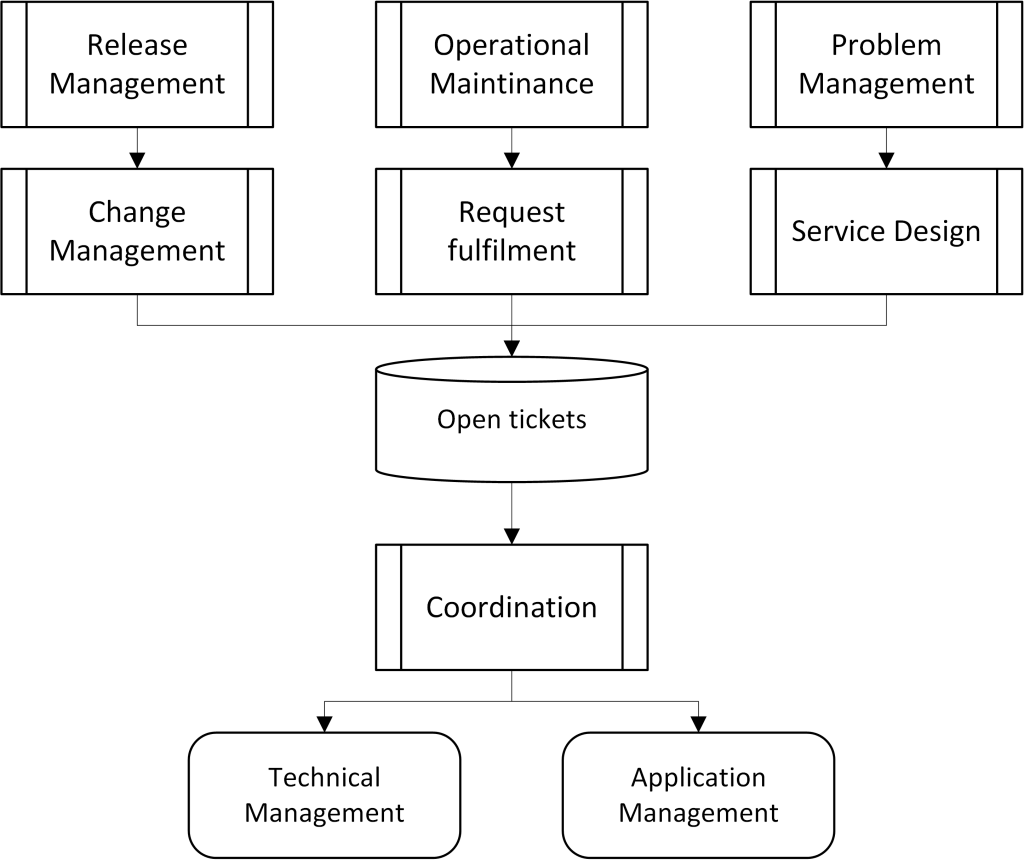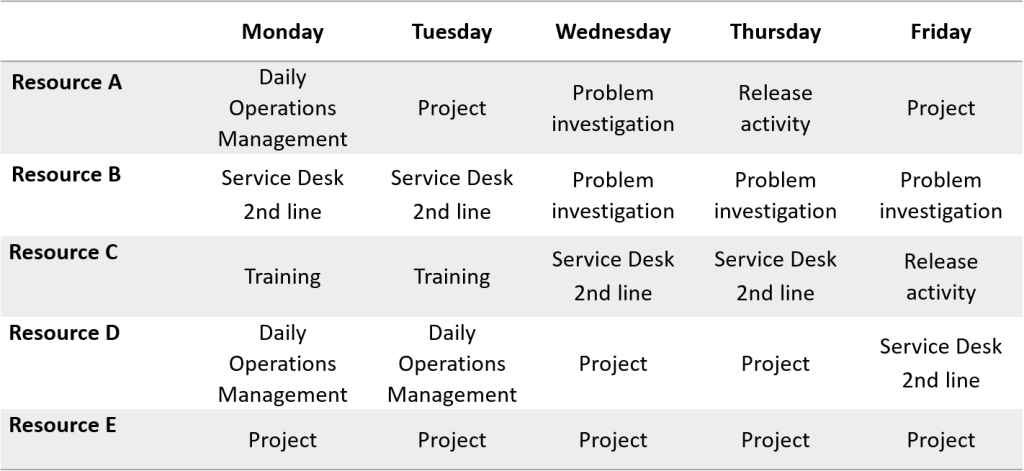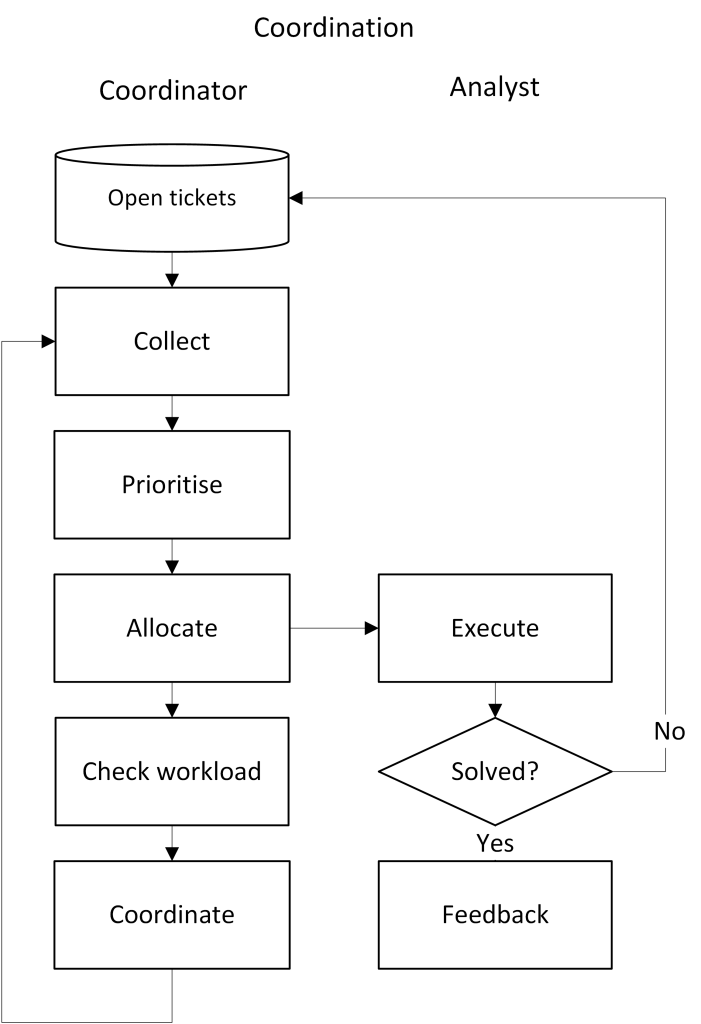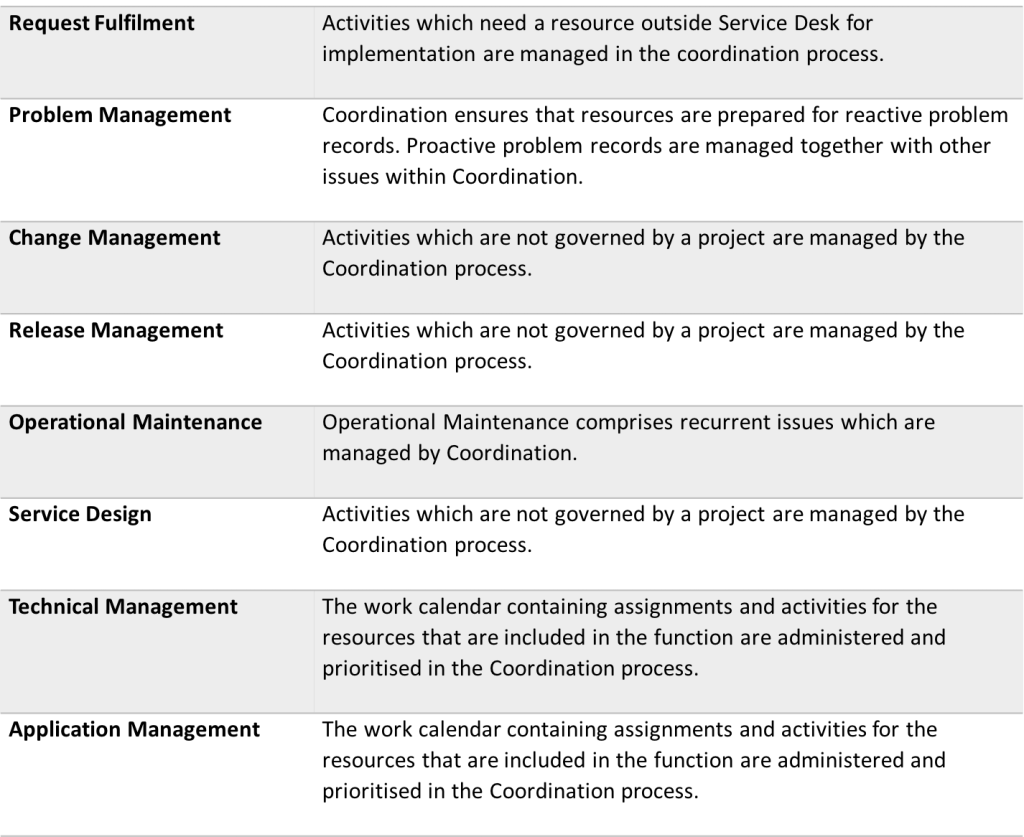Most IT organizations have limited resources. This means that the resources there is are easily overloaded with issues and assignments, which in turn result in the business experiencing unnecessarily long delays in getting something done. In order to avoid this, it is common for issues to be directly allocated to a resource without there being a plan for implementation in place. The result is consequently that each resource ends up with a pile of issues.
This is unfortunately the everyday reality for many staff within IT organizations, and for many of them, normality is not having time for everything that they are allocated. The behavior that develops can then be to do what is most enjoyable or to help the person who shouts loudest. In the worst case, it can go so far that employees develop stress-related illnesses. Many other organizations which have a high throughput of issues, for example, healthcare, car workshops or other service operations, use overall coordination of issues so that individual employees can work in peace. This also provides the conditions to enable issues to be prioritized at the right level and on more business-like grounds than whoever shouts loudest.
The coordinator function has the task of distributing resources and staffing roles in the everyday work within the IT organization. The coordinator functions as the spider in the web, and should have control of all resources on every occasion and for all activities that take place. This in order to be able to rapidly prioritize and redistribute resources.

Purpose
The purpose of Coordination is to create an acceptable work situation for the IT organization’s staff. No technical analyst or applications analyst should be allocated more assignments than they can manage within the forthcoming period.
The process also has the purpose of enabling prioritization at an overall level and on business-like grounds. If the amount of issues exceeds the IT organization’s total resource capacity, Coordination provides effective data to enable the IT Steering Group to make decisions on new recruitment or to contract in consultants.
Coordination enables the IT organization to present statistics on how much it has to do.
The purpose is achieved through:
- Receiving and coordinating orders that are processed by Service Desk
- Overall responsibility that all roles needed for the everyday operation are staffed
- Control of all resource calendars
- Overall control of issue flow and workload
Scope
Coordination is responsible for appointing resources for all activities and assignments within the IT organization. The specific assignment or issue is handled within the framework of the respective process and managed by the issue owner. It is only appointment of resources that is dealt with by Coordination. Coordination functions as a funnel to collect all ongoing issues and simultaneously a filter so that only the activities which must be performed within the forthcoming period go to the resources within Technical Operation and Application Management.

There is no reason to manage all activities separately in the process. It would take a great deal of energy and be administratively slow. issues located within the framework of a project should naturally be managed by the project manager. Roles or assignments where the issues are governed by someone else, for example rolling staffing by second line support in Service Desk, are not controlled at issue level by Coordination either. In these issues, it is the assignment ”participate in project X” or ”staff Service Desk” that is coordinated and entered in the resource’s calendar. The issues which then remain, i.e. which are too small to be defined as projects, are the issues that are managed and planned by Coordination.
A simple way to manage the planning is for the coordinator to have a weekly calendar where all resources are included. Everything that is planned for the resources is entered in the calendar so that empty boxes correspond to free time. This enables the entire IT organization to see who is doing what and what the total workload looks like.
To avoid unnecessarily burdening individual resources, as well as the risk of losing the overall view, it is important not to allocate more assignments than it is assessed can be dealt with during the week. Reactive problem records cannot be planned per issue, but instead are marked as a responsibility in the resource’s calendar. On this day the resource has responsibility for all reactive problem that are initiated from Service Desk. If there is time, other activities can be implemented provided that these activities are stopped if a reactive problem is registered.

Example of a simple weekly schedule that the coordinator can use for the resources.
Value for the business
Coordination provides effective statistics on workload within the IT organization. It gives the business a basis for making priorities regarding what is most important and also enables it to use the right resources for the right things, which increases the quality of what is delivered.
Moreover, Coordination provides the following value:
- Enhanced service for the users and perceived enhanced service level for the customer, which contributes to more satisfied customers
- Orders managed more effectively, which lowers the cost
- Increased knowledge about pending orders provides a greater chance of prioritizing that which is important for the business
- Increased control over the amount of issues. It provides a clearer basis on which the business can make decisions when ordering major projects
Activities
As Coordination entails appointing resources for issues in other processes, it does not have the steps which register and categorize the issue in this process. Neither is there a detailed description of how activities should be performed as this is in the respective process.
The following activities comes under Coordination:
Collect – Go through all current issues and also check allocated issues for which there is no feedback from the resource.
Prioritize – The priority is determined through a combination of current impact, future impact and time frame in accordance with the prioritization model.
Allocate – Go through the staffing of operational roles for the forthcoming period and enter them on the calendar for the resources. Plan and timetable the issues which have to be implemented during the forthcoming period.
Execute – The resource performs the assignment or the activities allocated.
Solved – If the resource does not have time to finish the activity or if other problems arise, the issue has to be returned to the coordinator for new planning.
Feedback – The resource provides feedback on the activity and documentation in accordance with the set procedures.
Check workload – Check the amount of non-planned issues and assess the resource’s workload. If there is a risk that the issue will not be dealt with within the agreed time, function managers should be contacted about the situation.
Coordinate –Coordinate ongoing issues and reallocate if necessary.

Documentation
The following documentation should be included within the framework of Coordination:
- Resource calendar for planning
- Procedures to request resources
Relationships with other processes and functions
Coordination has links to many other processes. The most common are listed here:

Trigger
Coordination is triggered through:
- Orders being escalated from Service Desk
- Reactive problems initiated by Service Desk
- Operational assignments having to be performed
- Projects needing resources
- An assignment having to be performed
- A new time period having to be planned and timetabled
Input
The following inputs are needed for Coordination:
- Access to all resources’ calendars
- Documented Operational Maintenance
- Access to the ticket management system
Output
The following outputs are generated by Coordination:
- Scheduled and resourced assignments
- Activity implemented
- Staff with a lighter workload
- Statistics on the total workload
Measurement
This is how Coordination can be measured:
- Number of issues implemented
- Number of open issues
- Number of issues implemented per resource
- Average time from request for resource to implementation
Challenges
Technical analysts and applications analysts are often very protective of their own calendars. There is a resistance to opening them up and allowing a coordinator to determine what should be done when. At the same time, there is a conception that there is too much to do and that it would be nice not to have to deal with everyone shouting that their issue is the most important.
If the IT organization can surmount this first obstacle, then most technical analysts and applications analysts feel that their everyday lives are much improved after coordination is introduced.
In addition, the following elements need particular attention when implementing the process:
- Everything that is done must be registered as an issue. Coordination cannot deal with what is not documented
- Find a suitable level for the objects that are coordinated
- Coordinating everything at issue level is slow
- Make the weekly calendar clear for everyone. A whiteboard on the wall for the overall weekly planning is often much more effective than electronic calendars

